In July 1974, the German Environment Agency (UBA) was established as the first national environmental authority in Germany. Our 50th anniversary is an opportunity to take a critical look back at our history, at our success and shortcomings, but also at the challenges bound to come our way.

In the social-liberal coalition led by Federal Chancellor Willy Brandt (1969 – 1974), environmental protection finally becomes an independent policy area. As early as October 1971, Hans- Dietrich Genscher, then Minister of the Interior responsible for environmental protection, presented the federal government’s first environmental programme. The programme recommends the establishment of a “Federal Office for Environmental Protection”.
On 22 July 1974, the German Environment Agency is launched with around 170 employees in Berlin (West). The decision is not without criticism – the SED newspaper “Neues Deutschland” speaks of an attack on détente.

To prevent hairspray from destroying the ozone layer, hairdressing products carry the “Blue Angel” label.
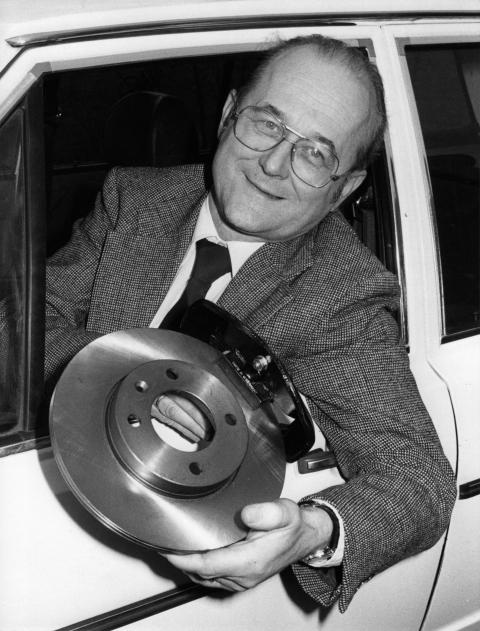
The lawyer Heinrich von Lersner (born 1930) becomes the first President of the German Environment Agency. Here he shows asbestos-free brake linings.
In the early years, the German Environment Agency is primarily concerned with air quality as well as ways to reduce noise and waste. By the end of the 1970s, the agency had around 400 employees.

Ahead of its time: The German Environment Agency presents particulate matter measurement technology at the Hanover Trade Fair in 1979. The issue does not reach the political arena until many years later.

In the early 1980s, the German Environment Agency presented an analysis of the causes and effects of acid rain. It recommends significant reductions of emissions, preferably directly at the power plants. Germany quickly takes on a pioneering role in air pollution control. Data from the German Environment Agency’s air monitoring network continues to provide important insights into the long-range atmospheric transport of air pollutants.
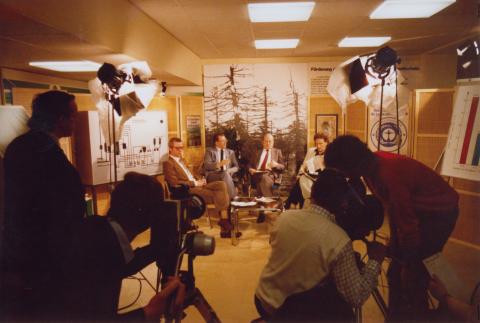
The German Environment Agency is frequently featured in the media: footage from the ZDF television programme ‘Tatsachen’ with President Heinrich von Lersner in the early 1980s.
In 1984, the German Environment Agency presents its “Data on the Environment” for the first time. The book launched a series of reports that are still among the German Environment Agency’s most popular publications today.
1980
The low-noise lorry developedjointly with industry is presented
1982
Chemicals Act: UBA examines the environmental impact of new substances
1983
The Large Combustion Plant Ordinance comes into force. With success: by 1993, sulphur dioxide emissions in West Germany alone had fallen by 89 per cent.
1980
The low-noise lorry developedjointly with industry is presented
1982
Chemicals Act: UBA examines the environmental impact of new substances
1983
The Large Combustion Plant Ordinance comes into force. With success: by 1993, sulphur dioxide emissions in West Germany alone had fallen by 89 per cent.
Public interest in environmental protection is growing: the German Environment Agency’s “Centralised Answering Service” receives more than 15,000 enquiries by 1980.

Federal recycling model: From 1981, the UBA tests whether waste can be mechanically separated and recycled at a test facility in Baden-Württemberg.

One of the German Environment Agency’s “environmental protection measuring vans” in Frankfurt’s pedestrian zone. The lettering of the “Bundesstelle für Umweltangelegenheiten”, the predecessor institution of the UBA founded in 1973, is still provisionally attached.
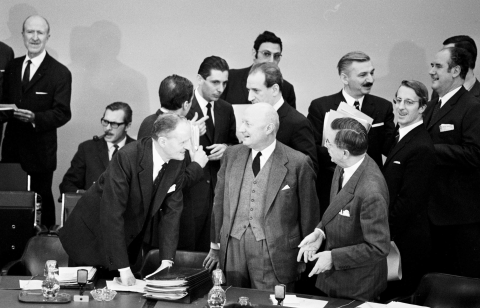

Unleaded petrol, a speed limit of “120 km / h” on German motorways or mandatory catalytic converters – the German Environment Agency’s recommendations do not always meet with approval from politicians, businesses and associations. With the large-scale model project “Bicycle-friendly city”, the German Environment Agency made a significant contribution to the cycling boom of the 1980s.
It has been official since 1987 that the amendment to the Detergents and Cleaning Agents Act stipulates that surfactants must be biodegradable. In addition, the information on environmental compatibility must be reported to the German Environment Agency.
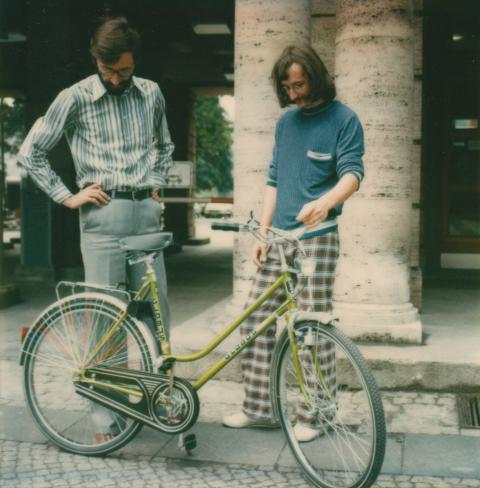
Attractive main prize: a modern and, above all, roadworthy bicycle. Since the 1980s, the UBA has also organised competitions to promote cycling as an environmentally friendly alternative to the car.

In 1988, UBA President Heinrich von Lersner demonstrates the vapour recovery process at a petrol pump. This technology is used to return toxic benzene vapours to the storage tank.
In 1988, for the third time, the German Environment Agency presents a comprehensive survey on noise abatement in Germany. Continuous noise increases the risk of illness and can have serious health consequences. Since its foundation, the UBA has therefore focused its activities on moise reduction.
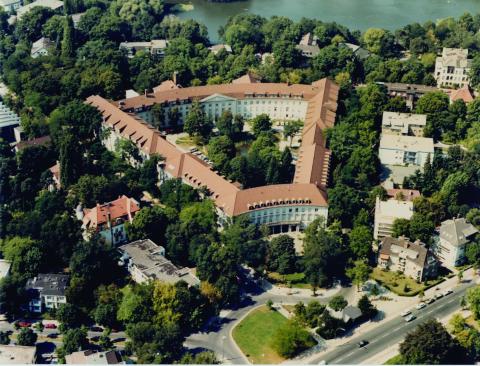
From 1974 to 1995, the German Environment Agency’s first office was a building constructed in the 1930s for the National Socialist Reich Labour Service on Bismarckplatz in Berlin- Grunewald

“The German Environment Agency has laid important groundwork for virtually all significant decisions and changes in environmental policy.”
Hans-Dietrich Genscher | Former Federal Minister

Active in climate protection at an early stage: the “Protection of the Earth’s Atmosphere” department begins its work in 1990.
In the course of German reunification, UBA is reinforced by around 200 employees from East German environment agencies.
After German reunification, the UBA inspected more than 1000 sites used by Soviet troops in East Germany to establish if they constituted environmental and health hazards due to contamination.
Following the dissolution of the Federal Health Agency, the long-established “Institute for Water, Soil and Air Hygiene” (“WaBoLu”) with around 300 employees and several branch offices are integrated into the UBA in 1994.
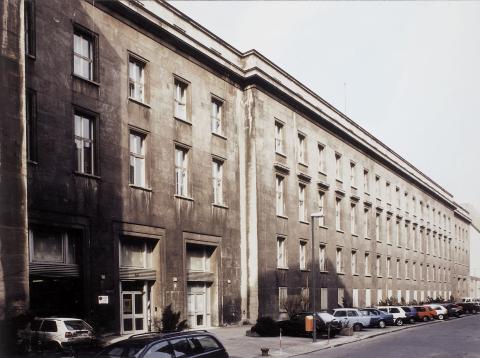
The temporary headquarters of the UBA in the former Reich Ministry of Propaganda on Mauerstraße in Berlin-Mitte after reunification

The “WaBoLu” office building on Corrensplatz in Berlin-Dahlem
It was not until 1994 that environmental protection was enshrined in the Grundgesetz in Article 20a. As early as 1970, Hans-Dietrich Genscher demanded in the first environmental debate in the German Bundestag: “The Basic Law does not yet recognise the word environmental protection. The catalogue of basic rights lacks a human right to a harmless environment.”

The “WaBoLu” test site in Berlin-Marienfelde, integrated into the UBA in 1994, in the 1980s
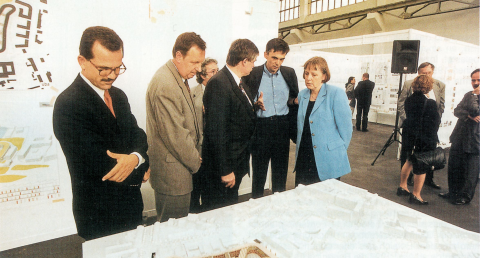

After 21 years under the leadership of founding president Heinrich von Lersner, the UBA gets a new president in 1995: Andreas Troge. The doctor of economics brings a new style and fresh impetus to the office.
1995
UBA‘s environmental specimen bank goes into regular operation after a trial phase lasting several years
1996
The Closed Substance Cycle and Waste Management Act comes into force
1998
Environmental Protocol to the Antarctic Treaty: UBA authorises travel and research in the Antarctic
1995
UBA‘s environmental specimen bank goes into regular operation after a trial phase lasting several years
1996
The Closed Substance Cycle and Waste Management Act comes into force
1998
Environmental Protocol to the Antarctic Treaty: UBA authorises travel and research in the Antarctic
In 1997, the study “Sustainable Development in Germany” opens up new perspectives: It is not only the state and industry that are responsible for environmental protection; each and every individual can also help. After all, the majority of environmental problems are caused by the prevailing patterns of consumption.
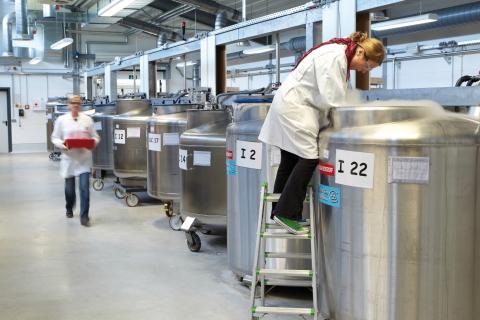
Environmental samples are stored in the Environmental Specimen Bank at minus 150 degrees Celsius – so they can still be analysed decades later
When a soil health law adopted in 1998 ignored major UBA recommendations, Andreas Troge remarked: “This is one of two major setbacks for the German Environment Agency.
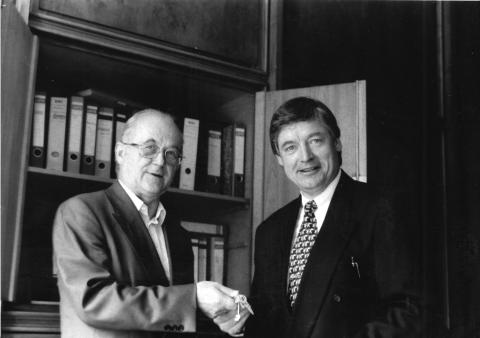
Handing over the keys: After 21 years at the helm of the UBA, Heinrich von Lersner hands over the reins to Andreas Troge.
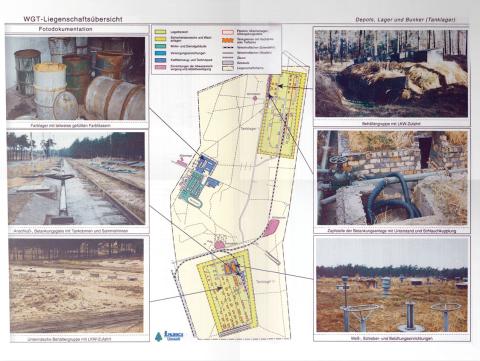
In 1995, UBA completes its project to assess contaminated military sites on former Soviet bases in Germany

The EC Environmental Noise Directive comes into force in July 2002. It is intended to reduce noise pollution throughout Europe. The German Environment Agency played a key role in its development.
The new flowing and still water simulation facility (FSA) is built at the Berlin-Marienfelde test site. Among other things, the UBA is researching how chemicals affect plants and animals in water.
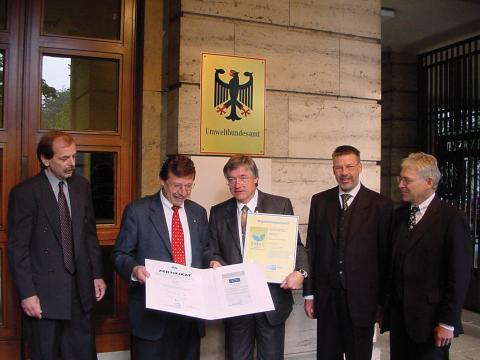
2001 – UBA is the first German authority to be awarded the EMAS seal of approval (environmental audit)
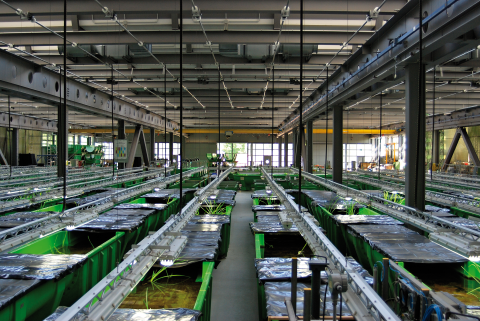
A test set-up with the plastic channel segments of the flowing and still water simulation facilities (FSA) of the UBA in Berlin-Marienfelde
The German Emissions Trading Authority (DEHSt) has been responsible for the implementation of EU emissions trading in Germany at the UBA since 2004. The new department was set up within a short space of time – just in time for the Europe-wide start of emissions trading in 2005 – it turns 20 in 2024.

Newly qualified environmental experts: In cooperation with partners, the UBA offers training programmes in environmental protection for developing and emerging countries.


In May 2005, the UBA moves its main office to Dessau. The move into the newly constructed ecological model building is the result of a decision by the Federal Government to locate more authorities in the new federal states.
From 2005, the dumping of untreated municipal waste in landfill sites is banned. The UBA carried out essential preparatory work for the new ordinance.
In the same year, limit values for particulate matter in the air come into force with the help of the UBA. These form an important basis for the EU directive that comes into force in 2008.
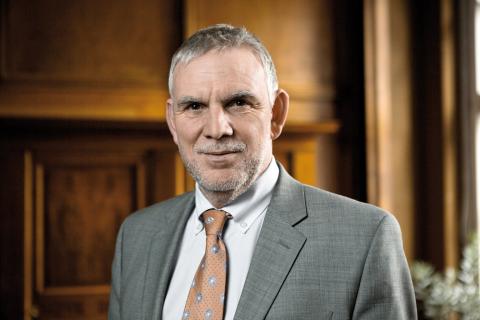
Jochen Flasbarth (born 1962) becomes the third President of the German Environment Agency in 2009. He heads the agency until December 2013 and then becomes State Secretary in the Federal Ministry for the Environment.

Internationally active: On an inspection trip, UBA checks whether the rules of the Antarctic Treaty are being adhered to.
In 2009, the Environmental Code finally fails – Federal Environment Minister Sigmar Gabriel abandons the project due to massive political opposition. The UBA had been a strong advocate of the issue for decades.
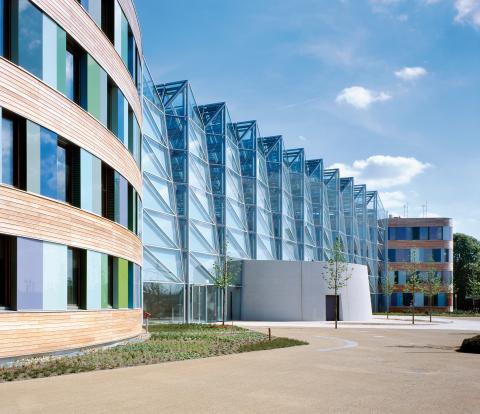
The new UBA building next to the site of the former Wörlitz railway station in Dessau-Roßlau

A comprehensive UBA study was carried out in 2010: Night-time aircraft noise increases the risk of cardiovascular diseases. The agency therefore recommends: No night flights between 10 pm and 6 am.
“Energy target 2050” – in 2010, a UBA study shows that it is possible to achieve a secure electricity supply from 100 per cent renewable energies. And at the end of 2013, in the study “Greenhouse gas-neutral Germany in 2050”, the UBA was able to show that it is even possible to reduce greenhouse gas emissions by 95 per cent in 2050 compared to 1990.
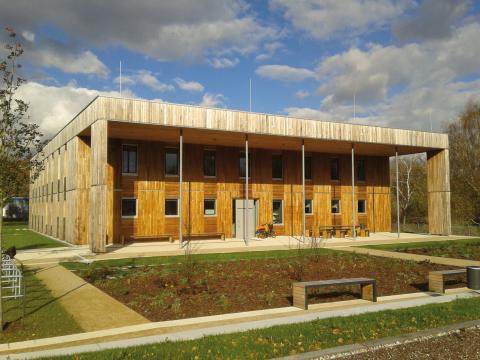
At the Berlin-Marienfelde site, the UBA builds the first zero-energy federal office building in 2013
Lead makes you stupid. And that is why there has been a strict limit since 1st December 2013. Drinking water may contain a maximum of 0.01 milligrams of lead per litre. As water from lead pipes cannot practically comply with this limit, the pipes must be replaced.

Always up to date online too: UBA’s completely modernised website is launched at the end of 2013. Thanks to the responsive design, the UBA website can be conveniently accessed from smartphones, tablets or computers.
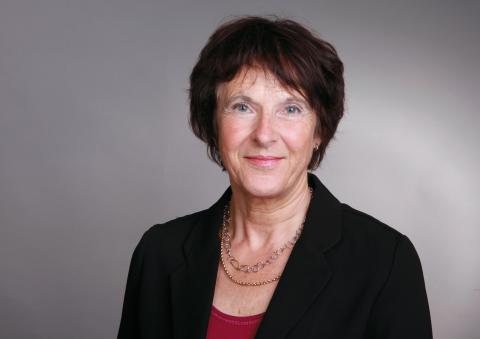
The fourth president is a female president: Maria Krautzberger (born 1954) becomes the first woman to head the German Environment Agency in May 2014.

“We are depleting our earth as if we were the last generation to live here.”
Heinrich Freiherr von Lersner (1930 – 2014)
President of German Environment Agency from 1974 to 1995

The diesel scandal comes to light in September 2015: Cars from wellestablished German and European manufacturers were found to have illegal defeat devices installed in their diesel vehicles. In 2017, measurements and modellings by the UBA show that the fleet of diesel cars emits even more nitrogen oxides on average than feared. In 2018, the UBA documented the associated health risks from exposure to this kind of pollution, such as lung cancer.
2015
HBM4EU, the seven-year EU project on human biomonitoring led by the UBA, is launched
Paris Climate Agreement: The world is united in its commitment to climate protection
2016
The world‘s largest marine protected area of 1.55 million kmÇ is established in the Ross Sea in Antarctica
2017
Special report by the Intergovernmental Panel on Climate Change on global warming of 1.5 degrees Celsius is published
2018
EU classifies the chemical bisphenol A as a “substance of very high concern”
2015
HBM4EU, the seven-year EU project on human biomonitoring led by the UBA, is launched
Paris Climate Agreement: The world is united in its commitment to climate protection
2016
The world‘s largest marine protected area of 1.55 million kmÇ is established in the Ross Sea in Antarctica
2017
Special report by the Intergovernmental Panel on Climate Change on global warming of 1.5 degrees Celsius is published
2018
EU classifies the chemical bisphenol A as a “substance of very high concern”
An increasing number of tiny pieces of plastic, known as microplastics, are being found in the ocean. Seabirds are starving to death because their stomachs are full of plastic, which they thought was food. The UBA therefore advises drastically reducing the amount of plastic entering the environment.
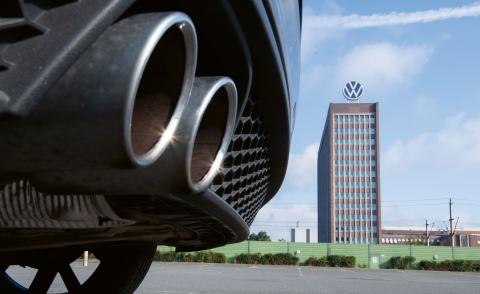
Diesel scandal with health risks – the UBA proves the consequences in 2018

UBA recommends reducing of plastic input into the environment
In 2018, climate protection becomes a global movement: schoolchildren go on strike on Fridays to insist on the implementation of the Paris Climate Agreement.
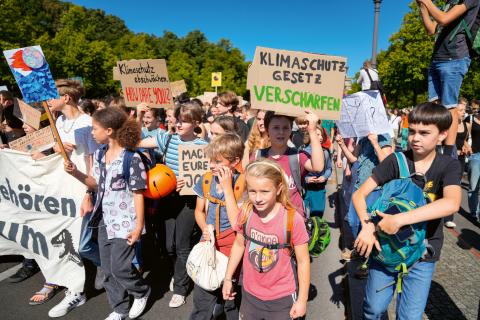
Pupils have been demonstrating on Fridays since 2018 worldwide for the implementation of the Paris Climate Agreement

The German Packaging Act enters into force in 2019, requiring producers to register in LUCID. As a result, more than 900,000 companies are financing the cost of packaging waste management, up from 55,000 companies before the legislation. Ambitious targets have helped Germany make significant progress in the field of packaging recycling. Since July 2021, single-use plastic products like certain cotton bud sticks, straws and cutlery have been prohibited.
In addition to debates on reducing the impact of plastic products on the environment, Germany is increasingly discussing the topics of "ventilation" and "aerosols indoors" during the coronavirus pandemic.

2021: Flood of the century in the Ahr Valley in western Germany
Since 2021, the national Emissions Trading Scheme (nEHS) sets a carbon price for the heating and transport sectors. Revenue from the nEHS is channelled into investments for climate protection, energy effi ciency and renewable energies.

UBA launches its “Air Quality” app. Citizens can use it to check the daily particulate matter (PM10), nitrogen dioxide and ozone levels in their neighbourhood from their mobile phones.
On 1 January 2020, sustainability researcher Prof. Dr. Dirk Messner becomes the new President of the German Environment Agency.

“All of the topics that the German Environment Agency deals with are now at the top of the political agenda: climate protection, the future of mobility and plastics in the environment, to name just a few.”
Prof. Dr. Dirk Messner, Präsident des Umweltbundesamtes

The Russian war against the Ukraine has global consequences – including for the environmental policy. In early summer 2022, a UBA task force analyses the eff ects of the war on food and energy supplies and the healthcare system. In face of the energy crisis triggered by the Russian war, the UBA will provides tips on saving energy in autumn 2022.
Around 240 million tons of mineral waste are produced in Germany every year. Thanks to the "Mantelverordnung", this waste can now be reused as substitute building materials in roads, buildings and other applications.
The UBA proposes aligning VAT more closely with ecological and social criteria and advises zero per cent VAT on fruit and vegetables as well as public transport. The package is intended to provide immediate relief for household budgets strained by the sharp rise in food prices and mobility costs, while at the same time protecting the environment.
The "Natural Climate Protection" action program worth 4 billion euros starts.
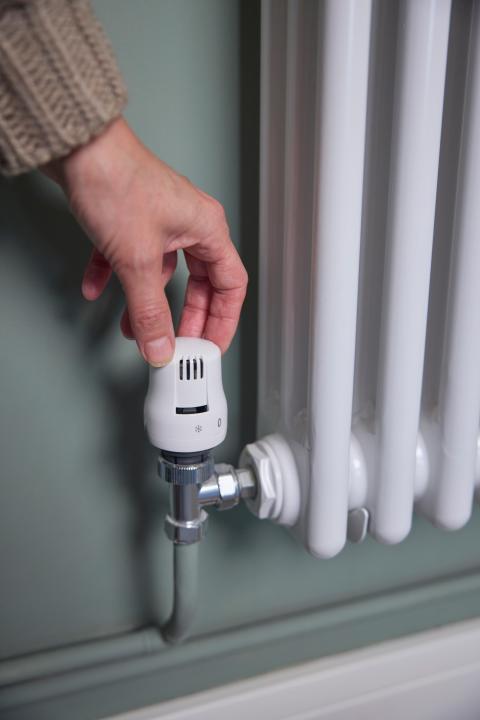
For the energy transition to succeed, energy consumption must be reduced. Energy can be be saved everywhere: in households, in industry and commerce and in transportation.

The Federal Government publishes the “National Water Strategy”
Salt discharges, heat and the formation of a toxic algae lead to a massive fish kill in the river Oder in September 2022. The Federal Environment Minister calls for more resilience for Germany’s waters.
The UBA is also taking part in negotiations at the International Seabed Authority. The end result is an international pause in deep-sea mining.
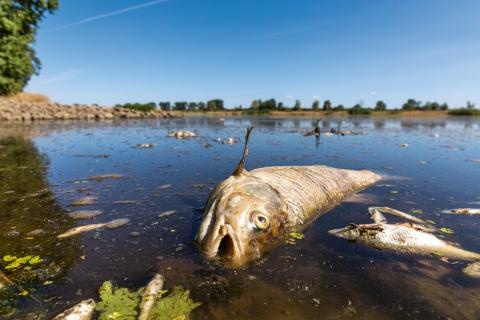
Major fish kill in the river Odercalls for more resilience for German waters
On 13 September and 31 October 2023, the report on the ecological status of the North Sea, the North-East Atlantic and the Baltic Sea is published by the Oslo-Paris Commission and the Helsinki Commission, respectively, which shows that the marine waters are not in good condition due to a variety of anthropogenic pressures.
2024 – 2050
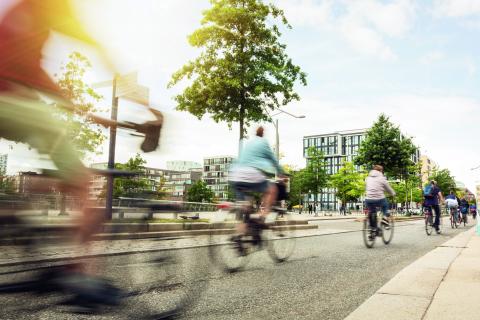

Meat is increasingly the subject of debate – and the popularity of substitute products in Germany is rising. The UBA study “Meat of the future” analyses the effects of the three alternatives – plant-based meat substitutes, edible insects and in vitro meat – on the environment and health.
UBA has been focusing on the “mobility of tomorrow” in Germany since 2016 as part of the European Mobility Week. New mobility options are being tested and road space is being changed to focus more on sustainability and quality of life. Information events and competitions provide new perspectives and inspiration for citizens.

Germany is increasingly discussing meat substitutes for a diet of the future

The AI laboratory at UBA supports sustainable environmental policy with environmental data analysis
Towards a sustainable future with artificial intelligence (AI)? UBA has had a laboratory for artificial intelligence (the AI Lab) since 2023. It lays the foundations for simplifying the analysis of large volumes of environmental data (big data) and facilitating sustainable environmental policy.
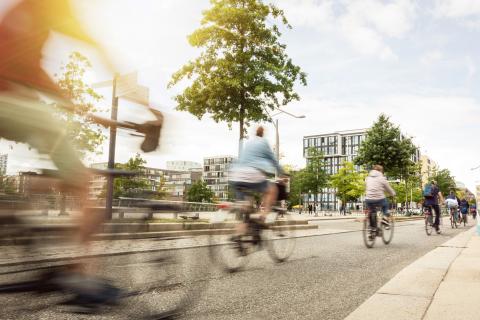
Mobility options oft he future are being tested and the focus is increasingly shifting to sustainability in urban space
Since September 2023, the UBA extension building in Dessau-Roßlau has been setting standards for the sustainable transformation of the construction sector and the climate-neutral federal administration: the building is completely self-sufficient in operation – thanks to photovoltaics and a heat pump. Environmentally friendly building materials such as recycled concrete and insulation with renewable raw materials are a matter of course.

Since September 2023, the UBA extension building in Dessau-Roßlau has been setting standards for the sustainable transformation of the construction sector and the climate-neutral federal administration: the building is completely self-sufficient in operation – thanks to photovoltaics and a heat pump. Environmentally friendly building materials such as recycled concrete and insulation with renewable raw materials are a matter of course.
The UBA’s founding site on Bismarckplatz in Berlin will open its doors to the German Emissions Trading Authority in the second half of the 2020s after extensive refurbishment. The 1930s building not only fulfils the Gold Standard for refurbishments, but also offers “New Work Zones” for the work of tomorrow.
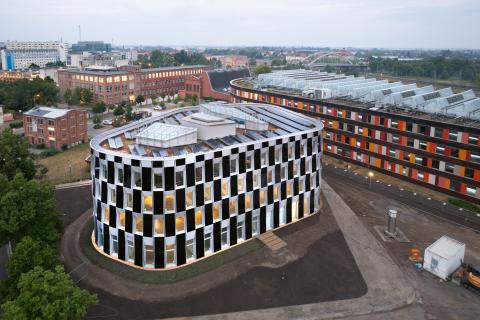
The construction of buildings releases large quantities of greenhouse gases. It is therefore important to recycle building raw materials better and keep them in circulation. Since 2022, the UBA has been focusing on the transformation of existing buildings, sustainable building materials and energy efficiency with the “AdNEB – Rethinking the New European Bauhaus” project.
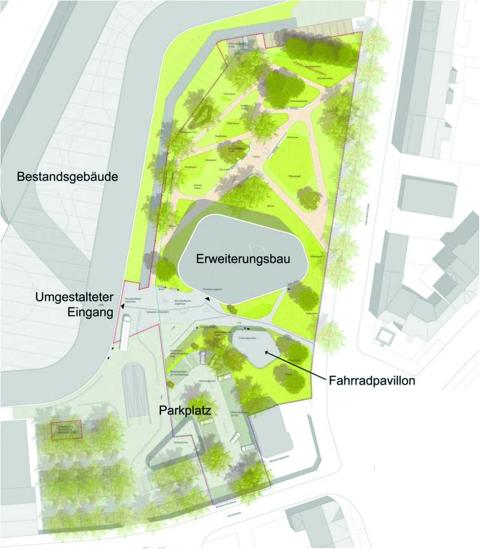
Photovoltaics, geothermal probes and a heat pump supply the UBA extension building with renewable energy. A public green space with seating surrounding the building.
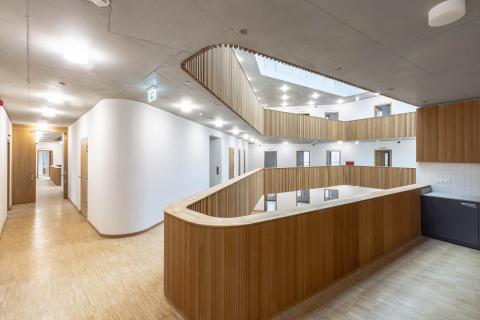
New building sets an example – The climate-neutral UBA extension building in Dessau

